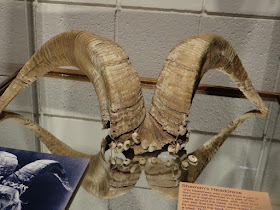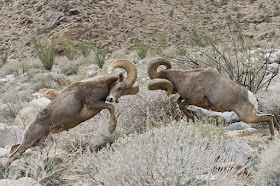How the hell did I end up here? When I was at school, my two most hated subjects were history/archaeology and biology...And yet today I will talk about animal calendar markers in the Alósaka cult of the Arizona's Hopi tribe.
 |
| Pic Binoche et Giquello |
The above figurine is a rare representation of Alósaka/Muyingwa, two aspects of the (supreme?) being or deity of the Hopi Kachina pantheon: the God of Germination and God of Growth of Corn...
There is also possibility that Alosaka and Muyingwa were two brothers (soon to see why this is important) and not two aspects of the same god. In any case, he/they lived in the Underworld and was/were the one(s) who made the seeds sown by the Hopi germinate and grow...
This two-horned deity was associated with rain. The symbols on the cheeks and at the base of the two horns are rain clouds. The long black hair at the back of the mask symbolises the curtains of heavy rain that this spirit is supposed to bring to irrigate the fields...
Alósaka/Muyingwa was the main god of the Aaltu (Two-Horned Priests) sect or secret/sacred society...Photograph by H.R. Voth, from the "Book of the Hopi" by Frank Waters
 |
| Pic H.R. Voth |
During the religious ceremonies, these guys wore Headdress of Alósaka, like this one: Basket head cap with a twine and two imitation horns of rawhide leather. Previous S.N. Los Angeles collection (not further specified)...
 |
| Pic by unknown (to me) author... |
These ceremonial headdresses with fake leather horns were supposed to help the priests to personify either the horned god Alósaka, or the animal from whom the god borrowed his horns: the Desert Big Horn sheep...
 |
| Pic by Andrew Barna |
Some ceremonial headdresses of the Two-Horn priests of Alósaka were actually made with real Big Horn sheep horns, like this one kept in the College of Eastern Utah Prehistoric Museum...
 |
| Pic by Tim Riley |
Both Horn God Alósaka (or his Two-Horned priest wearing Desert Big Horn sheep horns headdress) and Desert Big Horn sheep were found depicted on petroglyphs from the Hopi area.
 |
| Pic by Moki John |
 |
| Danny Rodman |
Soooo...What's all this about? Why do we have a horned god, a deified Desert Big Horn sheep, associated with rain and corn?
The answer is animal calendar markers...
Now, animal calendar markers are ancient calendar markers derived from the annual mating (most often) or birthing or migrating or hibernating habits of the animal in question...
In this case that animal is Desert Big Horn sheep...Their mating season is Jul–Oct. During that time, desert bighorn sheep, which normally live in separate ram and ewe bands, get together in big mixed herds to party baby!!! 🙂
Well every really good party with loads of horny guys all going for the best girl, eventually ends in fighting...Desert Big Horn rams are no exception. They charge at each other head-on crashing their massive horns together with tremendous impact...And bang...
 |
| Pic by Anthony Mercieca |
Now this is not something you can miss if you lived anywhere near...Every year at the same time you would start hearing mighty crashing of ram's horns...And so this part of the year became known by Hopis as "the time of the Big Horn Rams"...
This would have been just a very very annoying time of the year, when everyone walked around with cheese in their ears (🙂) if something else very very very very important didn't happen at the same time...
To understand what I am talking about, let's first have a look at the climate in Arizona...That spike you see in Jul/Aug/Sep is the arrival of monsoon rains...Only the most important annual event, the one that makes corn agriculture (and life) possible in Arizona...
Soooo...The Big Horn rams start banging their horns and spilling their semen at the same time when the sky god starts banging his thunder drums and spilling his heavenly semen, rain...
What do you think, how long did it take for Hopis to associate Big Horn Rams with the arrival of rain and to somehow magically correlate these two events? To turn Big Horn Ram into The Ram of Rain? And then to turn The Ram of Rain into The Ram Horned God of Rain?
BTW, you can see here why Alósaka/Muyingwa could have been one Big Horned God with two faces or two "brothers" Big Horned Gods...It takes two Big Horned Rams to produce the thundering sound that brings rain...🙂
So why would The Rain God also be The God of Germination and Growth of Corn? The Hopis relied on rains to grow corn, practicing dry farming in desert valleys that stretch between the mesas...No rain, no corn...
 |
| Pic by American Indian Magazine |
Because of the temperatures in the area, the corn planting in Hopi country may some years start as early as April, but most corn goes into the ground in late May and early June...You can read more about Hopi corn agriculture here
 |
| Pic David Wallace |
Corn seeds germinate after about 2 week, and the new corn seeds (cob) start forming after about 10 weeks...Now in order for corn to develop cobs it needs water and sunshine...Which is exactly what The Big Horned God provides when Big Horned Rams start banging their heads...
 |
| Pic World Wheel Community |
Soooo....There you have it...
I will finish this article with this ceremonial Alósaka screen. Just to add a cool plant calendar marker to the cool Animal calendar marker...
The pic is from "The Alósaka Cult of the Hopi Indians" by J. Walter Fewkes...
The entire middle screen is taken up by the depiction of the Horned God, Alósaka, holding in his right hand a cob of corn...A triple rain cloud symbol is depicted above god's head...So far so The Big Horned God of rain and corn...Nothing new...
In the lower left corner is the symbol of the sun...This guy minus feathers...
 |
| Pic Fred Kabotie |
Why? Cause the sunniest, hottest time of the year is also the wettest, the rainiest time of the year...Hence the constant confusion whether the supreme Hopi god was sun or rain god...
On each side of the screens are attached four artificial flowers. And on the right side of the screen, is what??? Well, J. Walter Fewkes didn't know...Let me see if I can help identify this "mysterious" 🙂 object...
Ever heard of Saguaro cactus? Only the most recognisable thing from the Hopi land...Is the Horned God, Alósaka looking at a cactus? And if so, why would the God of Grain be looking at a cactus while holding a corn cob?
 |
| Pic by Learn more every day |
Saguaro flowering begins around the last two weeks of April, and peak flowering occurs during the last week of May through the first week in June.
 |
| Pic by unknown (to me) author |
 |
| Pic by unknown (to me) author |
Saguaro flowering is triggered by winter rain as well as the increased day length, and warmer temperatures of spring.
To read more about ancient animal and plant calendar markers, start here…then check the rest of the blog posts related to animal calendar markers I still didn't add to this page, and finally check my twitter threads I still didn't convert to blog post...I am 9 months behind now...
But you can start here, with "The Goat of Rain" from Iran...Why goat of rain? Cause:
Ibex goats...
 |
| Pic by unknown (to me) author |
in Iran start banging their heads in Oct/Nov...
 |
| Pic by Cheryl Ann Quigley |
at exactly the same time when rain (god) arrives in that part of the world...
Which is why Ibex goat is the most depicted animal in Iran...
 |
| Pic by Bradshaw foundation |
 |
| Pic by Met Museum |
But before someone start talking about "Ancient Trans-Oceanic connections" and such stuff, I don't think that these two examples of Big Horned gods is a result of any such connection...It is an inevitable product of the hunter gatherers turning into farmers...
And farming needs some kind of calendar to tell you when to plough, when to sow, when to reap...A calendar which is in tune with the local climatic and vegetative cycle...
Now these hunter gatherers didn't know stars and such stuff to create stellar calendars...What they knew were plants and animals...And if you have animals that do the same thing every year, at the same time, then you can use them as calendar markers...
As agriculture become more and more important, and people start depending on it more and more, the animals related to the most important annual agricultural events become more and more important. To the point where they become deified...
And turned into gods...With characteristics of the original animal calendar markers animal...Or with the original calendar markers animal as their sacred animal...And this seems to have happen everywhere...And I believe totally independently...
It is just the way our brains work...It seems...
PS:
From "The Distribution of Rock Art Elements and Styles in Utah" by KENNETH B. CASTLETON, DAVID B. MADSEN





No comments:
Post a Comment